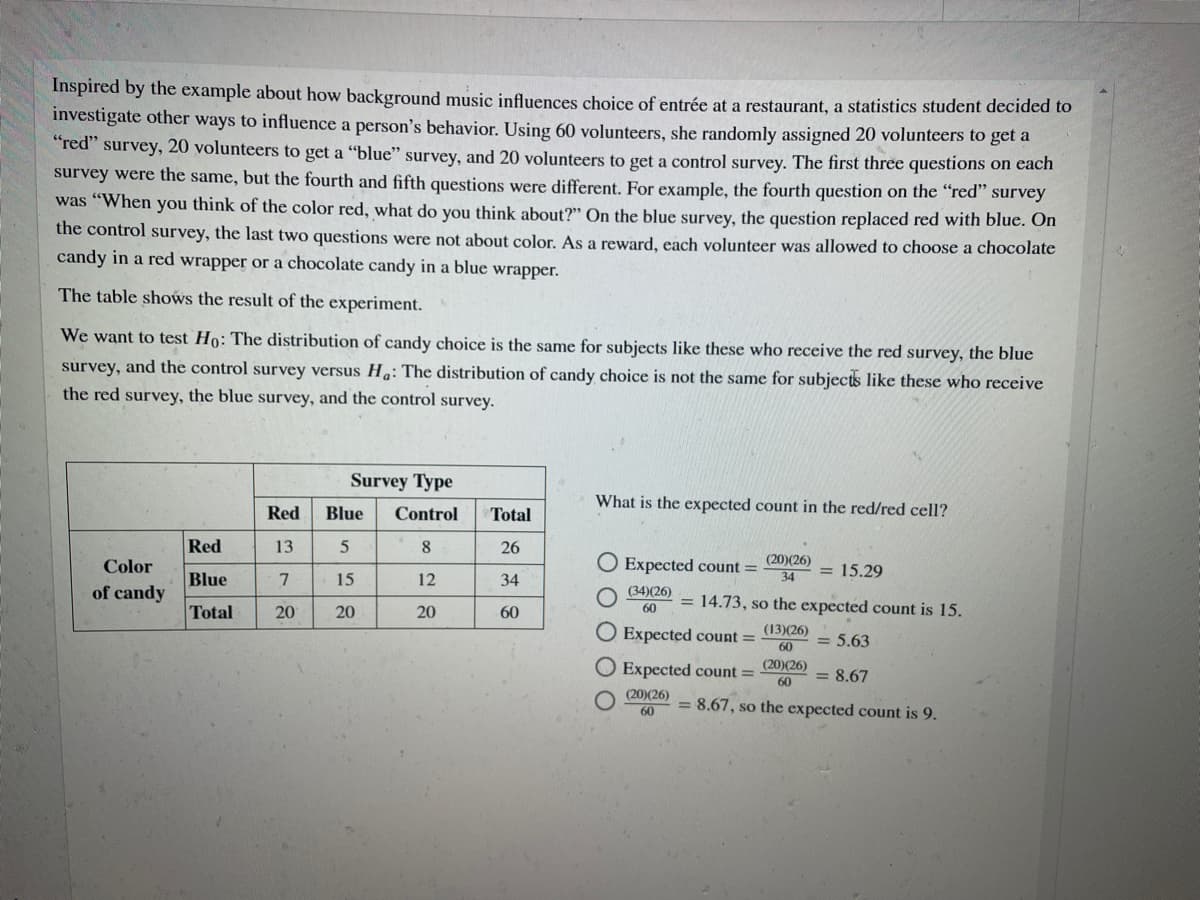Inspired by the example about how background music influences choice of entrée at a restaurant, a statistics student decided to investigate other ways to influence a person's behavior. Using 60 volunteers, she randomly assigned 20 volunteers to get a "red" survey, 20 volunteers to get a "blue" survey, and 20 volunteers to get a control survey. The first three questions on each survey were the same, but the fourth and fifth questions were different. For example, the fourth question on the "red" survey was "When you think of the color red, what do you think about?" On the blue survey, the question replaced red with blue. On the control survey, the last two questions were not about color. As a reward, each volunteer was allowed to choose a chocolate candy in a red wrapper or a chocolate candy in a blue wrapper. The table shows the result of the experiment. We want to test Ho: The distribution of candy choice is the same for subjects like these who receive the red survey, the blue survey, and the control survey versus Ha: The distribution of candy choice is not the same for subjects like these who receive the red survey, the blue survey, and the control survey.
Inspired by the example about how background music influences choice of entrée at a restaurant, a statistics student decided to investigate other ways to influence a person's behavior. Using 60 volunteers, she randomly assigned 20 volunteers to get a "red" survey, 20 volunteers to get a "blue" survey, and 20 volunteers to get a control survey. The first three questions on each survey were the same, but the fourth and fifth questions were different. For example, the fourth question on the "red" survey was "When you think of the color red, what do you think about?" On the blue survey, the question replaced red with blue. On the control survey, the last two questions were not about color. As a reward, each volunteer was allowed to choose a chocolate candy in a red wrapper or a chocolate candy in a blue wrapper. The table shows the result of the experiment. We want to test Ho: The distribution of candy choice is the same for subjects like these who receive the red survey, the blue survey, and the control survey versus Ha: The distribution of candy choice is not the same for subjects like these who receive the red survey, the blue survey, and the control survey.
Glencoe Algebra 1, Student Edition, 9780079039897, 0079039898, 2018
18th Edition
ISBN:9780079039897
Author:Carter
Publisher:Carter
Chapter10: Statistics
Section10.6: Summarizing Categorical Data
Problem 13CYU
Related questions
Topic Video
Question

Transcribed Image Text:Inspired by the example about how background music influences choice of entrée at a restaurant, a statistics student decided to
investigate other ways to influence a person's behavior. Using 60 volunteers, she randomly assigned 20 volunteers to get a
"red" survey, 20 volunteers to get a "blue" survey, and 20 volunteers to get a control survey. The first three questions on each
survey were the same, but the fourth and fifth questions were different. For example, the fourth question on the "red" survey
was "When you think of the color red, what do you think about?" On the blue survey, the question replaced red with blue. On
the control survey, the last two questions were not about color. As a reward, each volunteer was allowed to choose a chocolate
candy in a red wrapper or a chocolate candy in a blue wrapper.
The table shows the result of the experiment.
We want to test Ho: The distribution of candy choice is the same for subjects like these who receive the red survey, the blue
survey, and the control survey versus Ha: The distribution of candy choice is not the same for subjects like these who receive
the red survey, the blue survey, and the control survey.
Survey Type
What is the expected count in the red/red cell?
Red
Blue
Control
Total
Red
13
8.
26
Color
O Expected count =
(20)(26)
34
= 15.29
Blue
7
15
12
34
of candy
(34)(26)
= 14.73, so the expected count is 15.
Total
20
20
20
60
60
(13)(26)
O Expected count =
60
= 5.63
OExpected count =
(20)(26)
= 8.67
60
(20)(26)
= 8.67, so the expected count is 9.
60
Expert Solution
This question has been solved!
Explore an expertly crafted, step-by-step solution for a thorough understanding of key concepts.
This is a popular solution!
Trending now
This is a popular solution!
Step by step
Solved in 2 steps with 1 images

Knowledge Booster
Learn more about
Need a deep-dive on the concept behind this application? Look no further. Learn more about this topic, statistics and related others by exploring similar questions and additional content below.Recommended textbooks for you

Glencoe Algebra 1, Student Edition, 9780079039897…
Algebra
ISBN:
9780079039897
Author:
Carter
Publisher:
McGraw Hill

Big Ideas Math A Bridge To Success Algebra 1: Stu…
Algebra
ISBN:
9781680331141
Author:
HOUGHTON MIFFLIN HARCOURT
Publisher:
Houghton Mifflin Harcourt

Holt Mcdougal Larson Pre-algebra: Student Edition…
Algebra
ISBN:
9780547587776
Author:
HOLT MCDOUGAL
Publisher:
HOLT MCDOUGAL

Glencoe Algebra 1, Student Edition, 9780079039897…
Algebra
ISBN:
9780079039897
Author:
Carter
Publisher:
McGraw Hill

Big Ideas Math A Bridge To Success Algebra 1: Stu…
Algebra
ISBN:
9781680331141
Author:
HOUGHTON MIFFLIN HARCOURT
Publisher:
Houghton Mifflin Harcourt

Holt Mcdougal Larson Pre-algebra: Student Edition…
Algebra
ISBN:
9780547587776
Author:
HOLT MCDOUGAL
Publisher:
HOLT MCDOUGAL